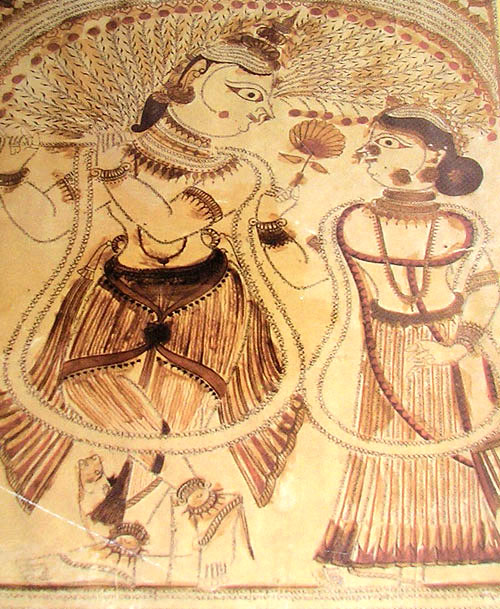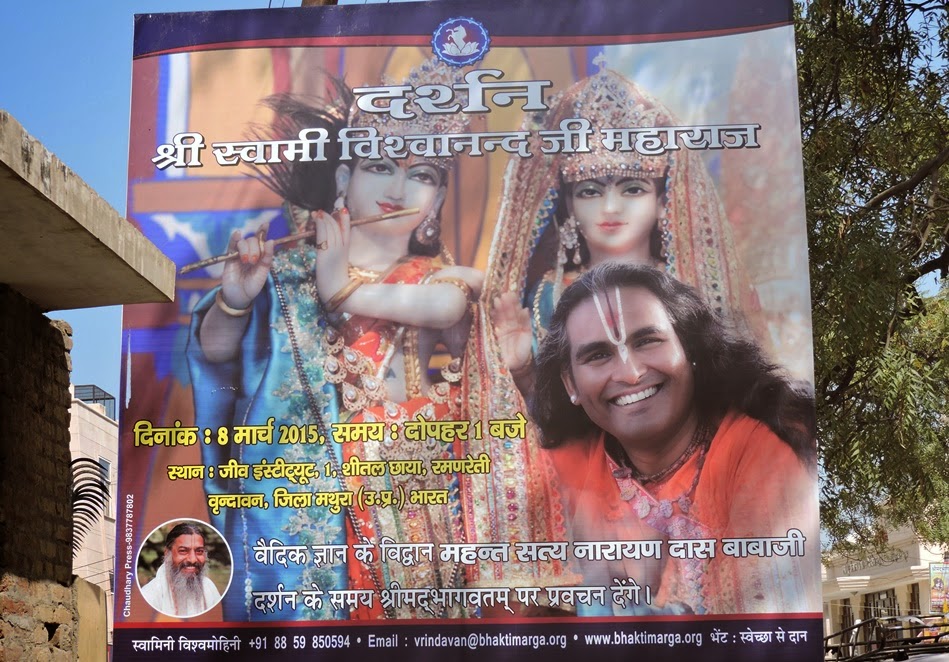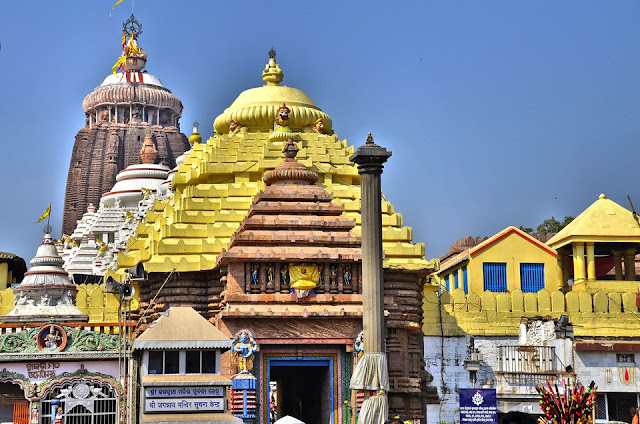Five Essential verses of Gita Govinda (Verse 5)
Now we come to last verse in our series. This is also the last verse that Rupa Goswami quotes from an external source in Ujjvala-nīlamaṇi. The context is the following verse, which is the last "idea" that Sri Rupa presents in his discussion of madhura-rasa.
vidagdhānāṁ mitho līlā-vilāsena yathā sukham |
na tathā samprayogeṇa syād evaṁ rasikā viduḥ ||
na tathā samprayogeṇa syād evaṁ rasikā viduḥ ||
Clever lovers find that there is more pleasure in all the varieties of their mutual dealings than there is in sexual union per se. This is the conclusion of the knowers of rasa. (15.253)
pratyūhaḥ pulakāṅkureṇa niviḍāśleṣe nimeṣeṇa ca
krīḍākūta-vilokite’dhara-sudhā-pāne kathā-narmabhiḥ
ānandādhigamena manmatha-kalā-yuddhe’pi yasminn abhūd
udbhūtaḥ sa tayor babhūva suratārambhaḥ priyambhāvukaḥ
krīḍākūta-vilokite’dhara-sudhā-pāne kathā-narmabhiḥ
ānandādhigamena manmatha-kalā-yuddhe’pi yasminn abhūd
udbhūtaḥ sa tayor babhūva suratārambhaḥ priyambhāvukaḥ
As the battle of the love arts began,
there arose so many obstacles--
When they tried to embrace each other intensely,
they became covered in goose bumps;
when they tried to look thirstily at each other,
their eyes still blinked;
As they drank the nectar of each other's lips,
they could not stop speaking loving words to one another--
The overwhelming joy that overcame them
was the biggest obstacle of all.
Thus truly was this beginning of their lovemaking
dear to them both. (12.10, UN 15.256)
there arose so many obstacles--
When they tried to embrace each other intensely,
they became covered in goose bumps;
when they tried to look thirstily at each other,
their eyes still blinked;
As they drank the nectar of each other's lips,
they could not stop speaking loving words to one another--
The overwhelming joy that overcame them
was the biggest obstacle of all.
Thus truly was this beginning of their lovemaking
dear to them both. (12.10, UN 15.256)
Rupa only quotes this verse after giving two of his own composition, both of which seem to be inspired by this one, and neither of which differs radically from it in tone. In each of the three verses, the actual sex act (samprayoga) is being interfered with by the foreplay, which for most people would not really constitute a radical difference.
The commentators, in particular Vishnudas, take the opportunity to stress the importance of Jayadeva as an authority. Vishnudas calls Jayadeva the first among the modern devotees (arvācīna-bhakteṣu) to relish the sweet essence of madhura-rasa of the Bhāgavata, the unequalled recipient of exclusive love for Krishna. (Commentary to 15.256). (arvācīna-bhakteṣu śrī-kṛṣṇa-premaika-pātratvenādvitīyānāṁ śrīmad-bhāgavatādya-rasa-mādhurī-sāraika-prathamāsvādakānāṁ sadā sarvatra sarvair api paramādaraṇīya-sac-caritānāṁ śrī-gīta-govindākhya-mahā-kāvya-kartṝṇāṁ śrī-jayadeva-caraṇānāṁ).
Prabodhananda reminds that this is the lovers are finally experiencing union after long yearning for it, they ae being overwhelmed by mounting ectsasies which cannot be restrained. Even horripilation was experienced as an intolerable obstacle. The trope of the intolerability of even blinking (nimeñäsahatä, UN 14.163) while gazing upon the beloved is found in various places such as 10.31.15 (jaḍa udīkṣitāṁ pakṣma-kṛd dṛśāṁ, also 9.24.65, 10.82.38). The lovers cannot find full peace of mind even in their union. Drunk with each other's physical presence they prattle; every one of their senses is so awakened that they wash over the couple like waves of the ocean. All of this shows that the extreme limit of rasa has been reached (paramāvadhi-rasotpattir darśitā). They cannot get enough of their lovemaking (sambhogasya nālaṁ-pratyaya iti bhāvaḥ), and both the activity and the pleasure derived from it have reached a state without limit (kriyānandayoś cāpāratvam api dhvanitam).
aṅga-stambhārambham uttuṅgayantaṁ
premānandaṁ dāruko nābhyanandat
kaṁsārāter vījane yena sākṣād
akṣodīyān antarāyo vyadhāyi ||
premānandaṁ dāruko nābhyanandat
kaṁsārāter vījane yena sākṣād
akṣodīyān antarāyo vyadhāyi ||
Krishna's servant Daruka did not take pleasure in his ecstatic feelings of love, for they caused his limbs to freeze and thus caused a direct and significant impediment to his service of fanning the Lord. (BRS 3.2.62, CC 1.4.202)
Of course, one of the characteristics of the higher states of the erotic sentiment, according to Rupa, is that the most intense or most intensely inflamed ecstasies (sūddīpta-sāttvikas). [See UN 14.179, where this is considered a symptom of mohana-mahā-bhāva.]
ekadā vyaktim āpannāḥ pañca-ṣāḥ sarva eva vā |
ārūḍhā paramotkarṣam uddīptā iti kīrtitāḥ ||
uddīptā eva sūddiptā mahā-bhāve bhavanty amī |
sarva eva parāṁ koṭiṁ sāttvikā yatra bibhrati ||
ārūḍhā paramotkarṣam uddīptā iti kīrtitāḥ ||
uddīptā eva sūddiptā mahā-bhāve bhavanty amī |
sarva eva parāṁ koṭiṁ sāttvikā yatra bibhrati ||
When five or six of the sāttvikas become manifest simultaneously and are experience in their highest and purest state (paramotkarṣa), they are called "inflamed" (uddīpta). These inflamed ecstasies become most intensely inflamed (sūddīpta) in the state of love known as mahā-bhāva, where all ecstasies reach their highest stage (parāṁ koṭiṁ). (BRS 2.3.79, 81)
In his commentary, Vishwanath expresses a principle, which does not seem to be a quote, that the rasa experienced when desire is still unfulfilled is of an even sweeter taste. This principle establishes this as the most excellent manifestation of rasa (tṛṣṇāyāḥ śānty-abhāvāt sāvaśeṣo hi rasaḥ suraso bhavatīti nyāyena rasotkarṣa eva sthāpitaḥ). The principle appears to be derived from the world of entertainment: leave your audience clamoring for more.
The word rasotkarṣa used be Vishwanath here should be considered significant. We have just seen above that the same words are used in the context of the sūddīpta-sāttvikas. The same words also occur in the chapter on nāyikā-bheda and already alluded to above in our discussion of māna.
sarva eva rasotkarṣo madhyāyām eva yujyate |
yad asyāṁ vartate vyaktā maugdhya-prāgalbhyayor yutiḥ ||
yad asyāṁ vartate vyaktā maugdhya-prāgalbhyayor yutiḥ ||
The height of rasa is found in the madhyā nāyikā, in whom both the characteristics of the mugdhā and the prāgalbhā are manifest. (UN 5.42)
Perhaps most important for our discussion here, however, is its use in the first chapter of UN in the context of the paramour love (atraiva paramotkarṣaḥ śṛṅgārasya pratiṣṭhitaḥ, 1.19).
Now, even though the Gaudiya commentators on GG, Caitanya Das and Prabodhananda, both take pains to stress that GG describes the pārakīya love, there is actually no evidence of it, and indeed Jiva Goswami uses GG 1.1 and 12.27, the latter verse in several places, as evidence of the svakīyā mood. None of the usual features of the paramour love -- deceiving elders, in-laws or husband, the necessity for secrecy, fear of being found out -- are described anywhere in Jayadeva's text.
Nevertheless, the idea of obstacles is essential to the pārakīya mood, as all the supporting texts Rupa Goswami gives point to this one basic idea:
bahu vāryate khalu yatra pracchanna-kāmukatvaṁ ca |
yā ca mitho durlabhatā sā manmathasya paramā ratiḥ ||
yā ca mitho durlabhatā sā manmathasya paramā ratiḥ ||
Where there are many prohibitions, and where there is hidden desire, and where the lovers find union to be a rare and difficult thing to attain, this is where the god of love finds the greatest pleasure. (UN 1.20) [See also UN 3.20, 21]
In all three locations where Rupa Goswami discusses the subject of pārakīya mood, he justifies it by saying that Krishna has appeared in the world to taste rasa, implying that such an experience must be had in the world, which by nature is filled with obstacles. To limit the length of this discussion, we will quote only one such verse:
neṣṭā yad aṅgini rase kavibhir paroḍhā
tad gokulāmbuja-dṛśāṁ kulam antarena |
āśāṁsayā rasa-vidher avatāritānāṁ
kaṁsāriṇā rasika-maṇḍala-śekhareṇa ||
tad gokulāmbuja-dṛśāṁ kulam antarena |
āśāṁsayā rasa-vidher avatāritānāṁ
kaṁsāriṇā rasika-maṇḍala-śekhareṇa ||
When poets deny that the woman to another has a place in the descriptions of the primary (i.e., erotic) rasa, it should be understood that this rule is made with the exception of the lotus eyed beauties of the cowherd settlement, since the Supreme Rasika, the enemy of Kamsa, had them appear in the world so that he could experience this [pārakīya] rasa. (UN 5.3) [See also UN 1.21-22]
So, in the 15th chapter of UN, Rupa Goswami is summarizing the līlās connected to the madhura-rasa. What does it mean? It means that a story is necessary for the production of rasa. A story requires a plot and a plot requires obstacles, which in the terms of the rasa. As we have seen, the principal obstacle that makes the plot of the GG is that provided by māna-vipralambha, the separation coming from māna.
Then why not just say so? Why take this example from the very minor obstacles of ecstasy, which in one sense can barely be called obstacles at all, and draw from it the principle that sexual union (samprayoga) is less enjoyable to the lovers than their līlā-vilāsa, which from the example is characterized as the presence of obstacles?
Indeed, the entire question can be seen as the rasika answer to the theological question of diversity and unicity. God is One and becomes many, because without becoming many, there is no fulfillment of the promise of rasa. How can there be taste if there is no taster, no tasting and no tasted? But Rupa Goswami not only indirectly answers the question of the personal concept of God in terms of rasa, but also subtly points to the paradox that is found in other rasika sampradāyas, who without exception are votaries of Radha and Krishna in the eternal act of making love, or at the very least permanently ensconced in the love bower. This is called the nitya-vihāra.
There is, of course, a scriptural logic to this position: God is never separated from his energies. He never leaves Vrindavan, how can he be apart from Radha for even a moment? When the desire to be joined in erotic union with the beloved is the all-powerful motivator to all action, how can the all powerful Supreme Person be deprived of fulfillment for even a fraction of a nanosecond?
When Radha and Krishna are in separation that they are thinking most intensely of every element of their physical closeness. And, as argued in the BhP [Cf. 10.32.21, 10.47.29-31, 10.82.46-47, etc.], that is the reality. Radha and Krishna are always, in some dimension, in the nitya-vihāra, eternal union. But what Rupa is talking about is the human adventure in love: the realization of some fragment of eternal perfection that somehow represents the central point of our aspirations, the glow from which light pulses outward.
Most of the Vrindavan rasikas deny the existence of any real competition for Radha. But Rupa Goswami needles them with a series of verses in UN 9. In particular, the following:
hari-priya-jane bhāvā dveṣādyā nocitā iti |
ye vyāharanti te jñeyā apūrva-rasikāḥ kṣitau ||
ye vyāharanti te jñeyā apūrva-rasikāḥ kṣitau ||
Those who say that the rivalries between different competitors for Krishna’s love is improper should be recognized as really having no sense of rasa. (UN 9.41)
So, Rupa Goswami is merely stating something that is obvious from the point of view of the dramaturgist, who recognizes that obstacles to love, whether from rivals, external circumstance, or personal psychology, are what make a good story, and that God himself enjoys a good story. Even those who accept the nitya-vihāra are still obliged to accept some obstacles -- however minimal, such as those described here in our GG verse -- in order to enhance the experience of rasa.
Introduction.
Verse 1: Krishna, the Embodiment of the Erotic Rasa
Verse 2: Krishna, the Lover of Radha
Verse 3: Radharani's māna
Verse 4: Radha, the empress of love.
Verse 5: Rasa-niṣpatti.





Comments